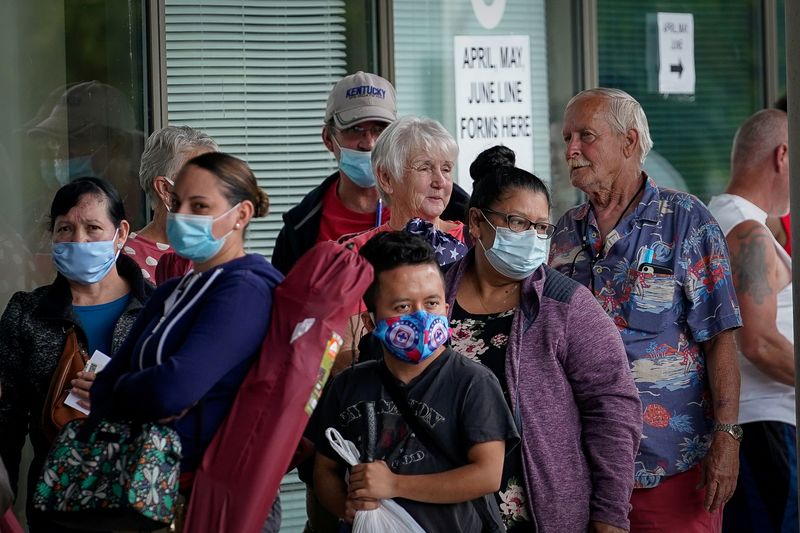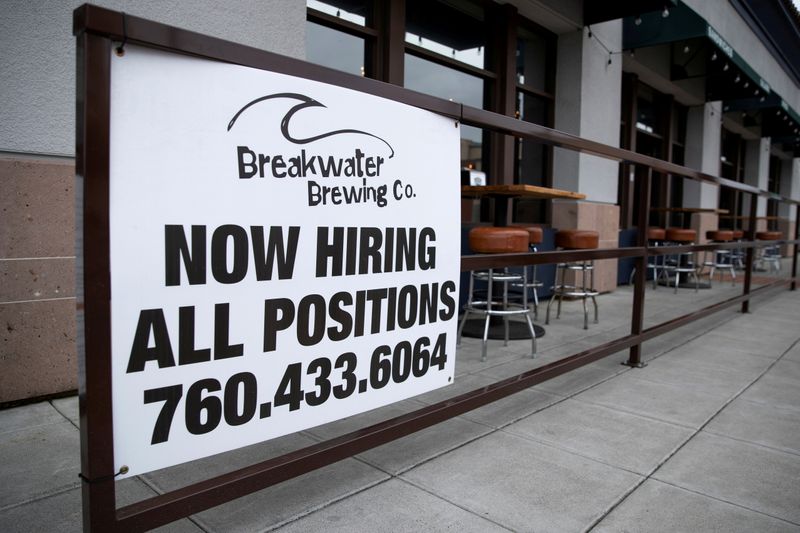By Lucia Mutikani
WASHINGTON (Reuters) - U.S. employment growth slowed considerably in November amid job losses at retailers and in local government education, but the unemployment rate plunged to a 21-month low of 4.2%, suggesting the labor market was rapidly tightening.
The four-tenths-of-a-percentage-point drop in the jobless rate from October reported by the Labor Department in its closely watched employment report on Friday occurred even as 594,000 people entered the labor force, the most in 13 months. Workers put in more hours, boosting aggregate wages, which should help to underpin consumer spending.
"Don't be fooled by the measly payroll jobs gain this month because the economy's engines are actually in overdrive as shown by the plunge in joblessness," said Christopher Rupkey, chief economist at FWDBONDS in New York.
The survey of businesses showed nonfarm payrolls increased by 210,000 jobs last month, the fewest since last December. But the economy created 82,000 more jobs than initially reported in September and October, a sign of strength. That left employment 3.9 million jobs below the peak in February 2020.
Nonfarm payrolls: https://graphics.reuters.com/USA-STOCKS/gdvzymwrqpw/nfpr.png
Despite November's slowdown in hiring, which also reflected a small gain in the leisure and hospitality industry, 6.1 million jobs have been added this year. Economists say the economy is very close to maximum employment, putting an early interest rate increase from the Federal Reserve on the table.
Fed Chair Jerome Powell told lawmakers this week that the U.S. central bank should consider speeding up the winding down of its massive bond purchases at its Dec. 14-15 policy meeting.
"The Fed will see the report as more than adequate to stay on course to accelerate tapering of asset purchases at the December meeting implying an end to purchases in March," said Andrew Hollenhorst, chief U.S. economist at Citigroup (NYSE:C) in New York. "Moreover, an unemployment rate that is poised to fall below 4.0% perhaps in the coming months keeps a first Fed rate hike in June or even earlier firmly on the table." Economists polled by Reuters had forecast that payrolls would advance by 550,000 jobs. Hiring continues to be hampered by worker shortages. There were 10.4 million job openings at the end of September.
U.S. stocks were trading sharply lower. The dollar rose against a basket of currencies. U.S. Treasury yields fell.
TIGHT LABOR SUPPLY
Employment growth was held back by a decline of 20,400 jobs in the retail sector. State and local government education employment fell by 12,600 jobs. That led to a drop of 25,000 in overall government jobs, the fourth straight monthly decrease.
Pandemic-related staffing fluctuations have distorted normal seasonal patterns in state and local government education. There have also been shortages of bus drivers and other support staff.
The leisure and hospitality sector added only 23,000 jobs compared to 170,000 in the previous month. Professional and business services payrolls increased by 90,000 jobs.
There were also solid gains in transportation and warehousing as well as in construction. Manufacturing employment increased by 31,000 jobs.
November's modest job growth did little to temper expectations that the economy was poised for stronger growth this quarter after hitting a speed bump in the third quarter.
A measure of services sector activity scaled a fresh record high in November.
Consumer spending and manufacturing activity have been strong. Spending should remain supported by rising wages as companies scramble for scarce workers. Average hourly earnings increased 0.3%, keeping the annual increase in wages at 4.8%. The average workweek climbed to 34.8 hours from 34.7. As a result of the longer workweek, aggregate wages rose 0.7%.
But the spread of the new, highly contagious Omicron variant of COVID-19 poses a risk to the brightening picture. While little is known about the impact of Omicron, some slowdown in hiring and demand for services is likely, based on the experience with the Delta variant, which was responsible for the slowest economic growth pace in more than a year last quarter.
While labor supply remains tight, there are signs that some of the millions of Americans who lost their jobs during the pandemic-induced recession are wading back into the labor force.
The smaller survey of households, from which the unemployment rate is derived, showed the labor force participation rate, or the proportion of working-age Americans who have a job or are looking for one, was 61.8%. That was the highest level since March 2020 and was up from 61.6% in October. The workforce remains 2.4 million below it pre-pandemic level.
Labor market participation: https://graphics.reuters.com/USA-STOCKS/movanqkxxpa/participation.png

"If more people are starting to look for work again, this would allow for stronger near-term hiring," said Gus Faucher, chief economist at PNC Financial (NYSE:PNC) in Pittsburgh, Pennsylvania.
The household survey also showed a rise of 1.136 million in the number of people employed. The employment-to-population ratio, viewed as a measure of an economy's ability to create jobs, jumped to 59.2%, also the highest since March 2020, from 58.8% in October.
